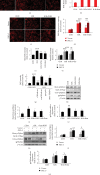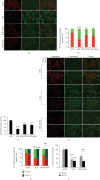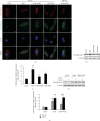Wenxin Granule Ameliorates Hypoxia/Reoxygenation-Induced Oxidative Stress in Mitochondria via the PKC- δ/NOX2/ROS Pathway in H9c2 Cells
- PMID: 32566078
- PMCID: PMC7260629
- DOI: 10.1155/2020/3245483
Wenxin Granule Ameliorates Hypoxia/Reoxygenation-Induced Oxidative Stress in Mitochondria via the PKC- δ/NOX2/ROS Pathway in H9c2 Cells
Abstract
Myocardial infarction and following reperfusion therapy-induced myocardial ischemia/reperfusion (I/R) injury have been recognized as an important subject of cardiovascular disease with high mortality. As the antiarrhythmic agent, Wenxin Granule (WXG) is widely used to arrhythmia and heart failure. In our pilot study, we found the antioxidative potential of WXG in the treatment of myocardial I/R. This study is aimed at investigating whether WXG could treat cardiomyocyte hypoxia/reoxygenation (H/R) injury by inhibiting oxidative stress in mitochondria. The H9c2 cardiomyocyte cell line was subject to H/R stimuli to mimic I/R injury in vitro. WXG was added to the culture medium 24 h before H/R exposing as pretreatment. Protein kinase C-δ (PKC-δ) inhibitor rottlerin or PKC-δ lentivirus vectors were conducted on H9c2 cells to downregulate or overexpress PKC-δ protein. Then, the cell viability, oxidative stress levels, intracellular and mitochondrial ROS levels, mitochondrial function, and apoptosis index were analyzed. In addition, PKC-δ protein expression in each group was verified by western blot analysis. Compared with the control group, the PKC-δ protein level was significantly increased in the H/R group, which was remarkably improved by WXG or rottlerin. PKC-δ lentivirus vector-mediated PKC-δ overexpression was not reduced by WXG. WXG significantly improved H/R-induced cell injury, lower levels of SOD and GSH/GSSG ratio, higher levels of MDA, intracellular and mitochondrial ROS content, mitochondrial membrane potential and ATP loss, mitochondrial permeability transition pore opening, NOX2 activation, cytochrome C release, Bax/Bcl-2 ratio and cleaved caspase-3 increasing, and cell apoptosis. Similar findings were obtained from rottlerin treatment. However, the protective effects of WXG were abolished by PKC-δ overexpression, indicating that PKC-δ was a potential target of WXG treatment. Our findings demonstrated a novel mechanism by which WXG attenuated oxidative stress and mitochondrial dysfunction of H9c2 cells induced by H/R stimulation via inhibitory regulation of PKC-δ/NOX2/ROS signaling.
Copyright © 2020 Qihui Jin et al.
Conflict of interest statement
There is no conflict of interest in this article.
Figures









References
-
- Chen W. R., Hu S. Y., Chen Y. D., et al. Effects of liraglutide on left ventricular function in patients with ST- segment elevation myocardial infarction undergoing primary percutaneous coronary intervention. American Heart Journal. 2015;170(5):845–854. doi: 10.1016/j.ahj.2015.07.014. - DOI - PubMed
MeSH terms
Substances
LinkOut - more resources
Full Text Sources
Research Materials
Miscellaneous

